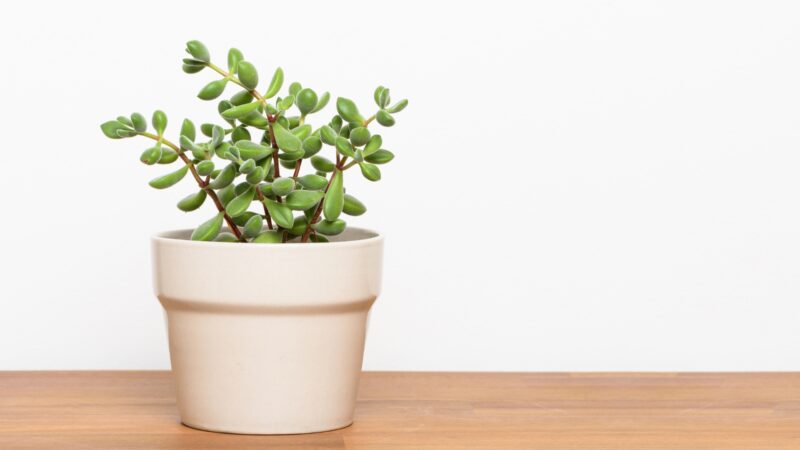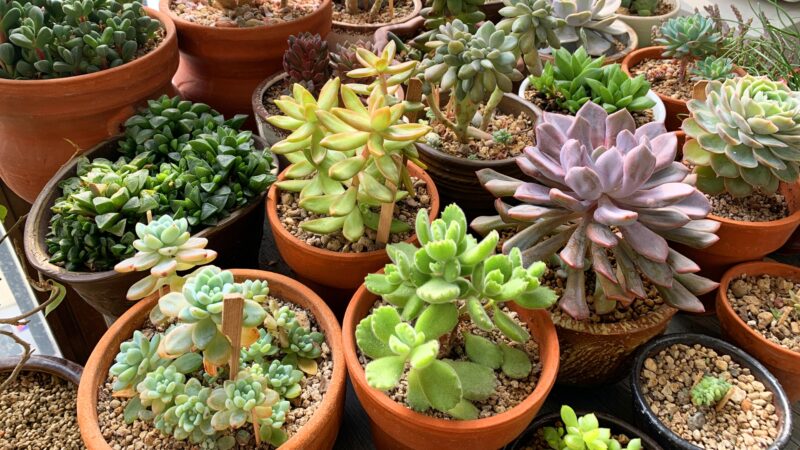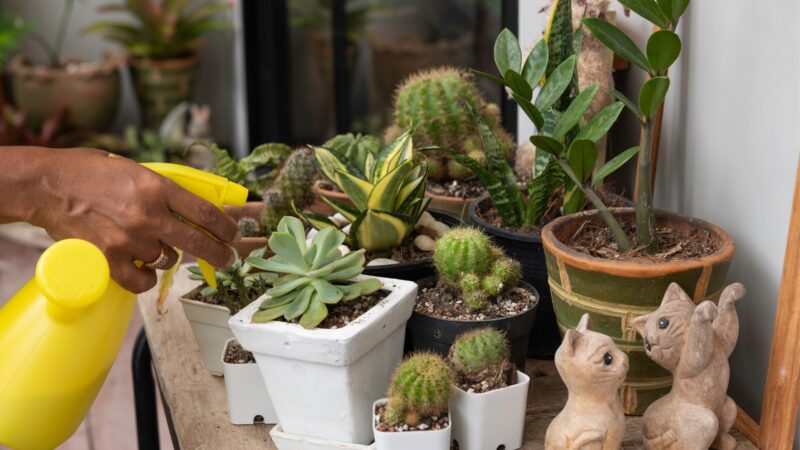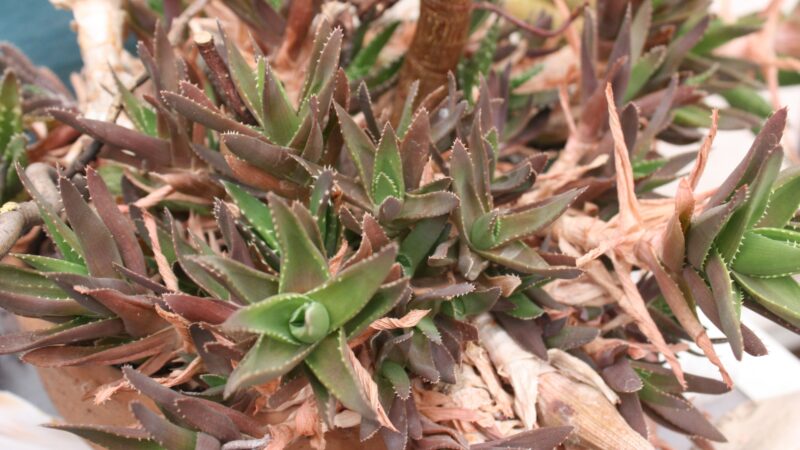Succulents are some of the prettiest plants out there. The fact that they’re not high maintenance makes them a top choice for a house plant. But as hardy as they are, they are not exactly invincible.
Like all plants, if they are completely neglected, they may also wither and die. And in this article, you’ll learn how to take care of them.
So before anything else, what are the causes of dying succulent plants? The following are the causes of dying succulents:
- They are overwatered.
- They are not getting enough water.
- They are exposed to the sun for too long.
- They have been exposed to extremely cold temperatures.
- They have rotten leaves and roots that were not removed.
- They have drooping leaves that were not removed.
- There is a pest infestation.
To be more specific, this article will help you tackle each problem from the root cause to save your succulents. You will also learn some tips and tricks to help prevent it from ever happening. Read on for more information.
What Are Succulents Plants?

Succulent plants, otherwise simply called succulents, are plants that are known to retain up to 95% of water in their stems, leaves, or both. They are notable for their thick, plump, and fleshy leaves.
Because of their ability to store impressive amounts of water, succulents do not require frequent attention from their owners. Interestingly, succulents are also quite hardy and can survive a variety of fluctuating temperatures. However, this is with the exception of winter’s sub-zero temperatures since succulents might freeze over when exposed to the cold for so long.
While most succulents appear green, other subspecies of the succulent family come in a variety of lovely colors. And since they do not require much water, sunlight, and care, they are quite popular as indoor decorative plants – especially for first-time plant owners.
Popular plants belonging to the succulent family include roseum, jade plant, pincushion cactus, and aloe vera, to name a few.
Can You Save a Dying Succulent?

You can still save a dying succulent. But to do so, you must be able to identify the cause to treat it properly. Otherwise, you might make things worse than it already is.
However, you should understand that reviving a dying succulent will take time. It does not happen overnight, so you should remind yourself to be patient as you wait for their recovery.
How Do I Know My Succulent Plant Is Dying?

It is quite easy to tell if your succulent plant is dying. Here are some of the warning signs that you should look out for:
- Mushy or wrinkled texture. Succulents have leaves that are firm and plump, which is owing to their high water content. However, when its leaves appear mushy or wrinkled, this is often a sign of overwatering or underwatering. And in either case, this will lead to the death of your plant.
- Pale yellow or brown leaves or stems. While succulents come in a variety of colors, haying pale yellow or brown parts are often a sign that these parts are starting to rot.
- Brown spots. Most succulents have plant parts that are of a solid color. If it appears to have brown spots, that is a big cause for concern.
- Drooping leaves. As earlier discussed, succulent plants are plump and filled with water. Despite their thick appearance, their leaves never appear like they’re drooping. Thus, drooping succulent leaves is a warning sign that there’s something wrong. This is, of course, except for vine succulents.
- Presence of pests. If you find a cluster of pests infesting your succulent, that’s also a sign that it is dying. Pests are attracted to rotting plant matter, so finding them there means that parts of it have already started to decompose.
Why Are My Succulent Plants Dying?

While succulents are known for being hardy, they are not invincible. If completely abandoned, then it will surely dry out and die eventually. With that said, common reasons why succulent plants include overwatering, underwatering, being exposed to the sun for too long, and not getting enough sunlight.
They may also die due to severe pest infestation, prolonged exposure to freezing temperatures, and natural rotting. All of these will be explained in depth below.
Overwatered Succulent Plant
Overwatering a succulent plant is one of the most common causes of its damage. Succulents are plants that can store a good amount of water in its body. As such, it does not require frequent watering – light sprinkling every week or two would suffice. Thus, when a succulent receives more water than it needs, it might rot and die eventually.
It’s easy to tell when succulents are overwatered because they lose their firm and plump appearance. This is replaced by leaves that have a mushy texture.
- Causes: Overwatering may be due to giving the succulent plant too much water, or the pot not draining well.
- How to revive: When succulents are overwatered, it’s easy to revive them. In this case, you should transfer your potted succulent to a place where it can get good amounts of sunlight to dry up faster. Once the plant doesn’t seem soaked anymore, you can replant it in a new pot with better drainage. Make sure the soil is well-draining to prevent another bout of overwatering.
Underwatered Succulent Plant
In contrast to overwatering, underwatering a succulent plant is another common reason for dying succulents. While they do not need much water, they still need regular watering to stay healthy. Otherwise, they will dry out and die – just like other plants.
When succulents are dehydrated, their leaves will look wrinkled and shrunken. Some leaves also turn a pale yellow or brown, and some even wither completely.
- Causes: The succulent was not given enough water or was not watered at all.
- How to revive: To revive an under-watered succulent, the easiest way is to soak it in water. Start by spraying water all over the plant and its soil. Before spraying more water, observe if the soil is absorbing the water – otherwise, this may lead to overwatering.
Continue to do this every other day until the succulent seems to have recovered. Once recovered, you can shift to sprinkling water at least once a week or as often as needed by the particular succulent plant.
Sunburned Succulent Plant
On average, succulents only need around six to eight hours of sunlight a day. Depending on the species, this may either be direct sunlight – as in the case of garden succulents or indirect sunlight – as in the case of indoor succulents. If the succulent receive too much sunlight, it might end up getting sunburned.
Signs of sunburn in succulents include dried brown spots, white marks, layers of dead and brown leaves, and leaf wrinkling.
- Causes: The cause of sunburn is prolonged exposure to sunlight, usually beyond what’s recommended for the particular succulent variety.
- How to revive: In the case of sunburn, the immediate course to take is to keep the plant in a place that’s away from direct sunlight. A place away from the window would be ideal. Then, you should carefully separate the damaged, dried, and dead leaves since they will not be able to produce food for the succulent anymore.
Frozen Succulent Plant
Another reason that can cause a succulent’s death is its freezing over. Due to the water content in its body, succulents are susceptible to being frozen. While succulents are tolerant of cold weather, it is not comfortable when it drops below 40 degrees Fahrenheit. Unfortunately, prolonged exposure to cold temperatures will lead to its death. When a succulent plant is frozen, its leaves turn to mush.
- Causes: A frozen succulent plant results from prolonged exposure to areas that have temperatures below 40 degrees Fahrenheit.
- How to revive: The best way to ensure the revival of a frozen succulent is to simply move it to a warmer place. During this time, it is advised to do nothing to your plant and simply wait for it to recover from the cold. Bear in mind that succulents are not comfortable if the temperature drops below 40 degrees Fahrenheit, so make sure to keep your succulents in a place that’s warm and dry.
Rotting Succulent Plant
Rotting is another problem faced by succulents. If you notice brown or dark brown spots or stems on your succulent, then there’s a chance that it’s beginning to rot. Unfortunately, you have to treat it as soon as possible to prevent the rot from further spreading and killing the entire plant.
- Causes: Rotting can be caused by overwatering the plant, lack of regular pruning, and fungal growth.
- How to revive: The first thing to do in case of a rotting succulent plant is to carefully remove all the rotting parts. Whether it’s the leaves, stems, or roots, all of them have to be detached from the healthy parts.
Once separated, you have to replant the healthy parts into a new pot. Make sure to use new soil and potting mix instead of the old ones since the old soil may be a source of fungi.
In the case that the succulent is severely damaged, you may opt to use a liquid fertilizer to further boost the plant’s absorption of nutrients.
Droopy Succulent Plant
Except for vine succulents, most succulent plants have upright and firm leaves. Thus, when its leaves start to look droopy, you know that something’s not right. Sometimes, these leaves will also look withered, wrinkled, or shrunken, depending on the type of succulent you have at home.
- Causes: When succulents look droopy, it’s often a sign that it has been dehydrated for so long.
- How to revive: To save a droopy succulent, simply shower them with more water at more frequent intervals. Watering them twice a week would suffice. Do so until the succulent looks plump and healthy again. Once the plant is healthy, you can revert to the usual watering schedule.
Infested Succulent Plant
Like all other plants, a pest infestation can cause quite a damage to your succulents. Common insects include aphids and mealybugs, who love feeding on the sap of succulents. Sometimes, these insects are attracted to rotting plant matter.
Unfortunately, it’s easy to identify if a particular plant is infested. If you happen to notice a cluster of bugs on your plant, you know there’s an infestation. At times, you will be seeing yellow to dark brown spots or bite marks on the succulent’s leaves.
- Causes: A pest infestation may have been caused by overwatering, fungal growth, or rotting plant matter.
- How to revive: To revive an infested succulent, the first course of action is to kill the pests. An organic insecticide can get rid of insects and fungal growth to make sure that another infestation does not recur.
Once the bugs are dead, the next step is to carefully get rid of the damaged parts. It also helps to re-pot the succulent and check if there is damage to the roots or not. Then, take extra care of your succulent until it looks healthy again.
How to Prevent Your Succulent From Dying?
- Mist them regularly. While succulents do not need a lot of water, they still require regular misting at least once a week. This depends on the type of succulent you have since some require more water than others.
- Give them enough sunlight. In general, succulents need around six hours of exposure to sunlight to stay healthy.
- Know what kind of soil they need. Succulents need soil that drains well. With that said, it’s best to plant your succulents on soil with sand or pumice.
- Monitor the pot if it is still draining well. There are instances when pots get clogged up over time. As a result, the water drainage becomes a problem, and that eventually soaks up the succulent. Unfortunately, a soaked succulent becomes unhealthy – that’s why you have to make sure that pots are always draining well.
- Make sure they are planted in the right-sized pots. While on the subject of pots, it’s also important that you know the right size pot for your particular succulent. A pot that’s too small won’t support the proper growth of the roots, while a pot that’s too big will result in the slow growth of the succulent. So as a rule, always do your research to determine the ideal pot size for your specific succulent.
- Take note of the temperature. Succulents are quite tolerant of hot and cold temperatures. However, they are not frost-tolerant and can even freeze over when exposed to the cold for too long. As a rule, keep your succulent in an area that will not go lower than 40 degrees Fahrenheit.
- Know when to feed them fertilizer. Succulents only need fertilizer at least once a year. And in most cases, you only need to feed them fertilizer when they are first planted or re-pot to help absorb the nutrients faster. Once they have grown into healthy succulents, it’s best to allow them to grow naturally without the need for any fertilizer.
Succulents are lovely plants that can truly breathe life into any home. With its wide array of colors and impressive hardiness, it’s the best plant for any indoor area. As long as you take care of them by misting them with water once a week and ensuring that they get enough sunlight, your succulent will surely grow into a beautiful and healthy plant.
Related: Succulent Pots and Succulent Planters | A Complete Guide